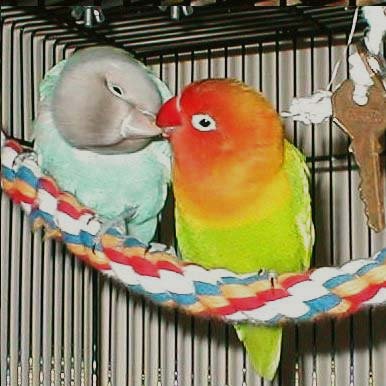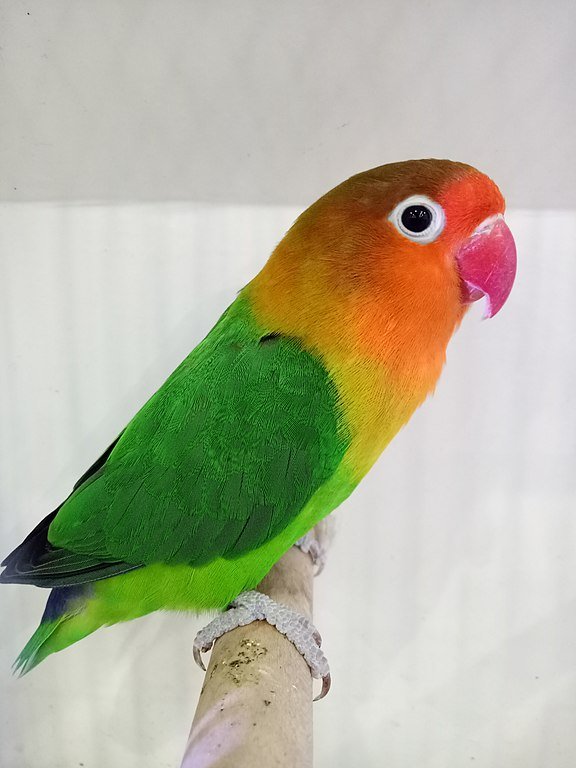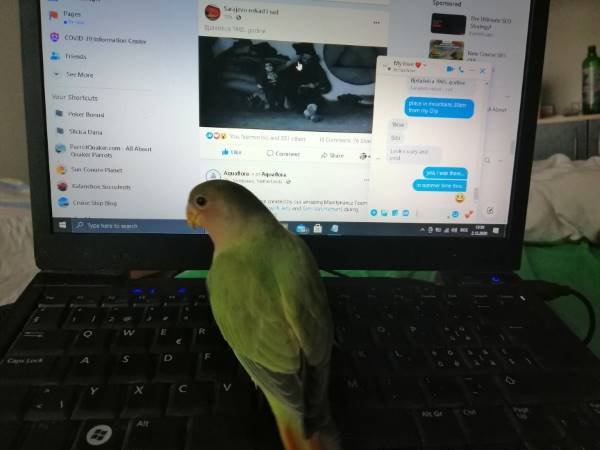Fischer’s lovebirds are small parrots that are extraordinarily attractive. They were discovered in the 19th century and are named after Gustav Fischer. They are brightly colored with up to seven different colors beautifully harmonized on each lovebird. The back, wings, and chest are colored green, the neck is golden yellow to orange color, on its face the orange is deepened, its beak is red, the top of the head is olive green, its tail is beautified with either blue or purple-colored feather, and the rest of the body is a vibrant green.
Fischer’s lovebird is full of energy and can be a loyal friend when they interact very well; they are calmer than other lovebird species, especially in an aviary environment. Fischer’s lovebirds are native to Central Africa, as with the peach-faced lovebirds. It is quite prolific in different parts of the world. However, its attractive plumage and unique personality make it the choice of so many bird lovers. Hence, the drastic decrease in the population of the Fischer’s bird. While Fisher’s are considered attractive pets, some consider them as pets.
Fischer’s Lovebird Lifespan
Fischer’s lovebirds may have small body frames, but they live longer than they look. They can live up to 20 years if they are well cared for and live a minimum of 12 years.
Personality and Behavior
Generally, lovebirds belong to the genus Agapornis from the Greek word “Agape,” which means love. They got this name from their behavior with their pair. Before you can say two humans are lovebirds, they both act inseparable or are always found around each other. It is the same with all lovebirds, and Fischer’s are no exceptions. They go as far as not relating with humans as long as they have a mate.
In the case of a single lovebird, they tend to form a strong bond with their owners or humans that give them attention. They are pretty curious and always on the go. They are attention lovers, and owners should be well aware of this. If you do not have enough time to spend with a single lovebird, try to get another lovebird for bonding. If that is not possible, get the lovebird toys to be busy with.
They are pretty territorial, and usually they will not allow you entering cage with hand. If they want you out they usually fluff their feathers put head down to floor and charge. They can deal really strong bite. You can check video bellow how my Daily chores with lovebird look like.
Aggression occurs also when a hen is in the breeding stage. They get aggressive when they are trying to defend their cages. They also get aggressive towards a male lovebird they don’t like. The hen may accept or reject the male through aggression, especially when introduced to a hen for breeding purposes.
Read about most common reasons lovebirds are biting here.
Talking Abilities
Now that you know that Fischer’s lovebirds are small parrots, you probably want to know if they are talking birds like the big parrots. The answer is no. Fischer’s lovebirds don’t talk or mimic human speech like the regular parrots. Although they mimic other household sounds like the sound of a microwave, whistling done by humans, and other noises, they choose not to speak like humans. It is, however, unknown why some parrots talk and some don’t. But it is discovered that those who speak are being taught from a very young age.
You can try to teach your lovebirds how to speak, but those who have tried to do that find it challenging. Though it can be difficult, it is possible because Fischer’s lovebirds can speak. They, however, make peculiar sounds that are more pleasant to the ears than other lovebirds.
Training your Fischer’s Lovebirds
It is essential to learn how to train your lovebirds if you want a well-behaved, fun, and cooperative lovebird. A lot of owners go years with their lovebirds without realizing that they are trainable. However, love birds can learn to stop biting, being aggressive, stop plucking, and stop pooping around if the owner can learn and have patience.
There are books and videos on how to train your lovebirds to do many things, from teaching them to be well behaved to teaching them how to do fun things. Lovebirds are intelligent animals, so it won’t be challenging to train them. However, you can use rewards to motivate them slowly when they achieve what you want them to do. However, you have to take things slow with the birds; that way, you build a solid relationship and bond with your bird, thereby ensuring that the lovebird gains your trust and feels safe with you.
Ensure that your lovebird is healthy before you start training it not to worsen its health condition further. You can consult bird enthusiasts, videos, and books.
Diet For Fischer’s Lovebirds
Fischer’s lovebirds feed mainly on seeds and grains. These are not the only things that the lovebirds can feed on, but they prefer the seeds and grains to other things. But as their owner, you must not feed your lovebirds only seeds and grains. They should be served seeds or grains moderately because feeding them seeds or grains alone can make them malnourished. Seeds and grains contain only a part of what is needed by the birds.
Therefore, the most recommended food for lovebirds is pellets. This is because pellets are made to contain a mix of different nutrients needed by the lovebirds. However, lovebirds don’t like to feed on pellets. Some don’t even see it as a food that can be consumed, and they prefer to starve themselves instead of eating pellets. That is why it is advisable to start your lovebirds on pellets at a young age. That will make the birds get familiar with pellets at a young age.
However, you can feed them a moderate amount of seeds and grains, but they should be complemented with fruits and vegetables. This should be done because fruits and vegetables contain the essential nutrients lacking in seeds and grains. You can also add cuttlebone, which is rich in Calcium and other trace elements like iron, potassium, and so on. Especially for egg-laying lovebirds because the hen needs a lot of Calcium during the period.
When it comes to water, Lovebirds are heavy drinkers, and yes, they need it. They need the water to stay hydrated and aid their digestion, and so they need about 5-10 ounces of water in a day. Make sure to clean their water bowls every day and also refill the bowls with water.
Read more about Diet For Fischer’s Lovebirds.
Fischer’s Lovebird combability with other parrots
It is normal to have a type of lovebird then wish to have another. But it becomes a problem when the only option you have is to house them together. If the birds are babies, they can be put inside the same cage, and they will always grow to love each other, but it can be dangerous if they are adults. Fischer’s lovebirds are pretty aggressive and can harm any other type of bird that is housed with. They tend to get familiar with something or someone they see from time to time and see the strange ones as a threat.

However, if the peach-faced is housed together with Fischer’s lovebird, they might grow up to like each other and mate in the process. While they will produce attractive birds, the birds won’t be able to reproduce young ones themselves. Therefore, to be on the safer side, the different types of Lovebirds should be housed separately.
Fischer’s Lovebird Breeding
Taking care of your hen at this stage can be rewarding or heartbreaking; it depends on how you choose to care for it. You don’t just put a male and female bird together and leave them to the rest of the process; there are steps to follow.
The first thing is to get a healthy and mature pair ready for bonding. At this stage, you have to be careful, especially if you are bringing in a male from outside. The hen might choose to reject or accept the male. If the hen accepts the male, you might get pretty jealous; but if the hen rejects the male you have introduced, it’s all war in there. The hen becomes aggressive when they do not like a male around them.

After getting your pair ready, it takes them no time to go straight into the business. And if you have several lovebirds but do not know if they have the same sex, you can try DNA sexing to know your lovebird gender. Meanwhile, you must have prepared a suitable place for the process to go smoothly and well. You can get or build a small front hole nest box with ready nesting materials to make your lovebirds feel at home.

You can check back from time to time to see the eggs that are laid. Egg Laying in lovebirds varies in numbers per time. Some lay about five eggs once, while some make it one at a time. There is nothing bad in checking for good and fertile eggs, but be careful not to mishandle the eggs. You can check for the membrane as a sign of a fertile egg by putting the eggs under a bright light to examine.
Then your lovebird’s health is essential. Take care of their food and water because the hen needs to replenish its lost nutrients at this stage and make healthy babies. You don’t have to stay there to feed the hen; the male never leaves its side throughout this process. The male becomes responsible for feeding the hen during the breeding stage. So romantic!
The incubation period takes about 22-25 days, and it can take a chick about a whole day to get out of its shell. It is better not to interfere, as most owners have killed their chicks in the process. Another reason not to interfere is that hens get aggressive at this stage of their lives, so they can harm you if you come too close.
After the eggs are hatched, if you are sure about handling the chicks properly, you can go ahead to help feed them, but if you have not done one before, it is better to provide the hen with what she needs, and she will do the job of feeding them the best way she can. After fledging, you might want to withdraw the chicks from the nest box into their cages; then, you can quickly start them on pellets. Doing that makes bonding with your new chicks easy and familiar with pellets before they become difficult adults.
Read more about baby care here.
Fischer’s Lovebird Cage size
Though Fischer’s lovebirds are small birds, they need enough space too. A good cage should have about 18″ x18″ x12″ dimension with bars not wider than three-quarter inches, the latter because the lovebirds are tiny in size. Fischer’s are energetic and playful birds, they are inquisitive and love to explore, and they have been found to make their way out of their cages in the past, so the cage door should not be one the birds can open easily.
Wooden perches should be made available as well as toys and, most significantly, papers. It is important to provide them with papers because it has become their habit to chew on paper, especially when breeding.
Fischer’s Lovebird Health Problems
Here is another reason to spend more time with your birds. Lovebirds generally exhibit preventive mechanisms and tend to hide their illnesses. If you spent more time with them, you would have known your bird’s behavior, how playful and energetic it is. The exact way you discover something is wrong with a toddler’s health is how you find out in birds because they stop playing around the usual way and show other symptoms that you need to start watching out for from now. The signs and symptoms of health problems in lovebirds include and are not limited to the following:
- Abnormal droppings
- Respiratory problems/ abnormal breathing
- Tail moving up and down constantly
- Discharge from the eyes, nostrils, or beak
- The face or head covered with undigested seeds, or mucus
- Dull or swollen eyes
- Feather growth
- Drooping tail, wings, or head
- Vomiting
- Weight loss
- Falling off the perch
- Loss of appetite
- Disorientation
The common diseases Fischer’s Lovebirds come down with include:
Malnutrition
Mainly, several diseases in lovebirds are caused by malnutrition. When they are not fed adequately, they come down with severe diseases like:
- Vitamin A deficiency– Retinol, also known as vitamin A is an essential vitamin needed for digestion, good eyesight, good appetite, and resistance to parasites and infections. You need to look for a way to supplement this vitamin if it is insufficient in your birds.
- Vitamin D deficiency– this means the lack of calciferol in the lovebird. Vitamin D promotes the intake of Calcium by the GI tract. Calcium is needed for strong bones, which is why it is important to feed your birds with enough Calcium. Cuttlebones are recommended as a good supply of Calcium. You can try to feed birds with it if it lacks enough Calcium.
- Obesity– birds that feed on too many seeds are prone to be overweight or obese because seeds are high in fat. Obese birds are more susceptible to fatty liver diseases and arthritis. You can feed your bird with sprouted seeds instead of struggling to give your bird what it won’t take from you. Sprouted seeds are lower in fat, as sprouting uses up the fats in the seed.
Respiratory problem
The respiratory problems include Aspergillosis, Pneumonia, Psittacosis, Parrot fever, and Chlamydia.
Beak and Feather disease
The Psittacine Beak and Feather Disease(PBFD) is a highly contagious airborne disease. It is a disease that should be prevented because it has no cure. It can only be maintained for a while as only supportive treatment is available.
If you ever find your lovebird showing any of these symptoms or noticing something unusual, consult an avian veterinarian.
Gender difference
Out of the nine species of lovebirds that exist, three are dimorphic, which means there are physical differences to differentiate between males and females just by looking at them. These are the Madagascar lovebird, Abyssinian lovebird, and red-faced lovebird. The other six, which include Fischer’s lovebirds, are monomorphic. Both males and females have the same physical characteristics.
While you cannot differentiate between the male and female Fischer’s by judging by their colors, you can find out their sex through some of their physical characteristics. The head, pelvis, and shoulder are usually broader in female lovebirds than the male. You might want to consult an experienced veterinarian to determine the gender of your monomorphic because if not properly handled, you can harm the bird.
If you are sure you can handle the bird well, make sure the bird’s back is laying on your palm and the head in between your second and third fingers. Slightly rub in between the bird’s legs to feel the Pelvic bones. If the bones are close together, then your bird is likely to be male, but if it is wide apart or wide enough for an egg to pass through, it is a female lovebird.
You can also determine the gender by vent sexing, but it is safe to consult a bird handler or an avian veterinarian if you need to do that.
Another way to know the gender of a fisher’s lovebird is by observing their behaviors. The hen is likely to exhibit nesting behaviors like shredding or tearing items in the cage. Hens are also the aggressive ones and, of course, the ones who lay eggs.
However, the most reliable method is testing through their DNA which can be done by a vet or by using a sample kit to get the DNA samples and then send them to the laboratory.
Fischer’s Lovebird Color Mutation
Fischer’s lovebirds are unique in their colors. However, the standard colors are not the only ones you can find; there are other colors of Fischer’s lovebird that you can always choose from. They include;
- Blue Fischer’s lovebird
- Dilute Yellow Fischer’s lovebird
- Lutino Fischer’s lovebird
- Cinnamon Fischer’s lovebird
- Black of dark-eyed white Fischer’s lovebird
- Albino Fischer’s lovebird
Fischer’s lovebirds are attractive and energetic birds. There is a lot to discover about these birds as you spend more time with them. The more you find out about them, the better you care for them. The more you care for them, the healthier they become. The healthier they become, the longer they live, and you can enjoy them for a more extended period.
Read more about Lovebird Colors Here.
Featured Photo Credit: Roel Balingit




